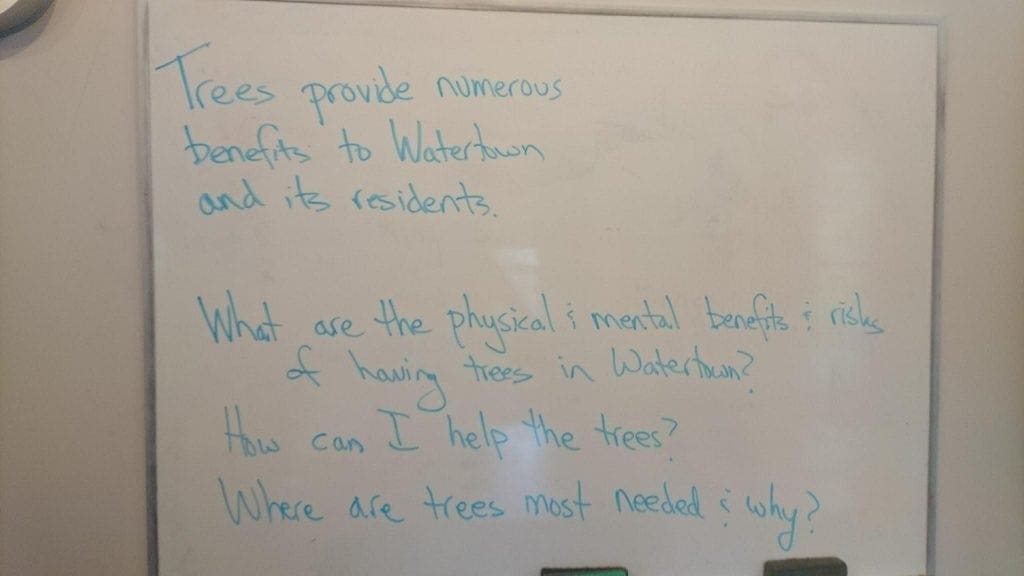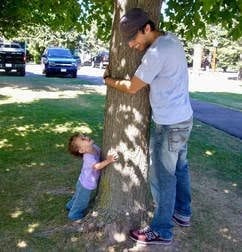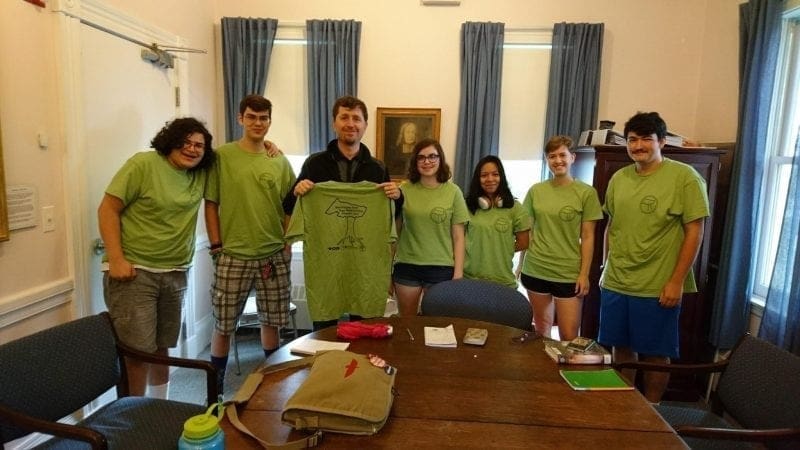Editor’s Note: Check out this step-by-step video of David facilitating the Question Formulation Technique in a high school science class.
This past summer I led a group of teenagers in Watertown, MA, in what will hopefully become an annual Trees for Watertown’s Teen Tree Stewardship Program. During the program teens learned about about their local tree canopy and its importance to public health. They did this in multiple ways: by learning how to identify tree species and taking measurements of tree health and tree size, by caring for trees through basic pruning and tree pit care, by researching the important roles that trees play in an urban environment, and by advocating for urban street trees through outreach activities. In addition, they went on multiple field trips to local parks, cemeteries and arboretums, they undertook research in the library, and updated the town tree inventory. These activities had the overarching goals of raising awareness about and connections to local trees.

Several of the teens arrived with a firm grasp of some of the benefits of trees, such as shade and beauty. But trees offer so many more benefits to the town and its residents, such as reducing asthma, improving stormwater management, and even decreasing crime. Trees require care and maintenance and through the support of a larger network of people to maintain their health. It quickly became clear that trees were a “wicked problem,” a site where competing interests and powers make challenges difficult to solve in a direct and causal way. Because of the networked-nature of trees, it proved difficult to define our boundaries around a specific list of topics and challenges.
As a former classroom teacher with experience in the Question Formulation Technique (QFT), I decided to incorporate the QFT as a tool to focus students’ enthusiasm and work in a way that would guide our thinking and vision, projects, and work.
During the second week of the program I introduced the QFT during our morning meeting time. I gave a quick overview of the QFT process and drew students’ attention to the difference between closed-ended and open-ended questions. Knowing that we probably wouldn’t use the process again, I didn’t delve too deeply; I wanted to keep the activity moving forward and to maintain teens’ interest on trees and leave time for us to spend outdoors. Having used the QFT numerous times in the classroom in the past, I strategically used certain steps of the strategy in order to expedite the process. Knowing that this end product, a list of guiding questions, would serve to structure the remainder of the program, the abbreviated approach best supported the learning objectives of the program.
I had originally considered the Question Focus (QFocus) “Trees can help us,” but found it to be too broad. Reflecting on the goals of the prompt, I adjusted the QFocus prompt to read: “Trees provide numerous benefits to Watertown and its residents.” The prompt was intentionally designed to allow teens to hone in on the ways that trees improve the environment as well as the effects that trees have on people.
The teens got into two groups of three and developed nearly 40 questions total about trees in Watertown. After they created their list I asked each group to flip two questions, one from open-ended to close-ended and the other from close-ended to open-ended. After this activity, I asked students to choose and share three priority based on the criteria of which questions would need to pursue as they moved into next steps. After each group shared their questions, many of which overlapped, the groups worked with their questions by combining wording and ideas into three central questions that would guide our work for the summer. Their emerging questions became:
- What are the physical and mental benefits and risks of having trees in Watertown?
- How can I help the trees?
- Where are trees most needed and why?

The QFT and students’ questions helped to make visible what we already knew as well as what we wanted other people to know. Further, the questions highlighted those areas that required additional information and expertise. The biggest success of this process, however, came with the level of ownership and buy-in the teens felt for their work. These were questions that they were interested in; they helped to orient their understanding of the problem, provided a scaffold for our future work and recognized the areas where they had gaps in knowledge or wanted to learn more. The questions also helped me, as the group leader, to provide learning opportunities for students to discover and explore their interests. Their guiding questions remained on the whiteboard through the remainder of the program, making visible their thinking and the work they were hoping to accomplish.
Given the open-ended nature of much of our work, the QFT was perfectly suited for our work and goals. This was a loosely-defined curriculum, with no strict benchmarks or assessments. Instead, we were left to create our own of learning opportunities, and the contours of our work was defined by students’ interests and motivations. While this type of freedom could have felt overwhelming, the QFT helped us all focus in on the task at hand, not through a set of discrete goals – those came later – but with a set of guiding motivations, in the form of questions. And these are questions that the teens and I continue to carry with us long after the conclusion of the program.
 David Meshoulam, a former high-school physics teacher, has recently taken a step away from formal classroom teaching to pursue a career in urban ecology. His newly forming organization, Speak for the Trees (sfttbos.org), aims to increase the size and health of the urban tree canopy in the greater Boston area through education, outreach, stewardship, planting, and advocacy. He considers trees to be powerful tools of connection and resilience: they bring people together, connect citizens to their neighborhoods, provide numerous health, ecological and environmental benefits, and generally make everyone feel happier. While he’s not busy tree-evangelizing, you can find him crafting science curriculum, teaching course on science education at Northeastern, Boston College, and Boston University, or taking care of his chickens and children in Watertown, MA.
David Meshoulam, a former high-school physics teacher, has recently taken a step away from formal classroom teaching to pursue a career in urban ecology. His newly forming organization, Speak for the Trees (sfttbos.org), aims to increase the size and health of the urban tree canopy in the greater Boston area through education, outreach, stewardship, planting, and advocacy. He considers trees to be powerful tools of connection and resilience: they bring people together, connect citizens to their neighborhoods, provide numerous health, ecological and environmental benefits, and generally make everyone feel happier. While he’s not busy tree-evangelizing, you can find him crafting science curriculum, teaching course on science education at Northeastern, Boston College, and Boston University, or taking care of his chickens and children in Watertown, MA.
